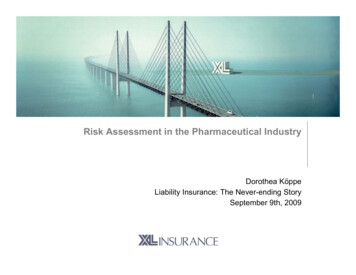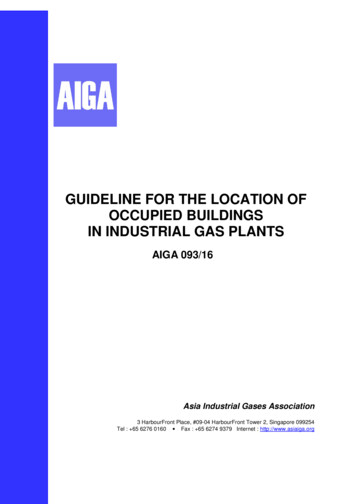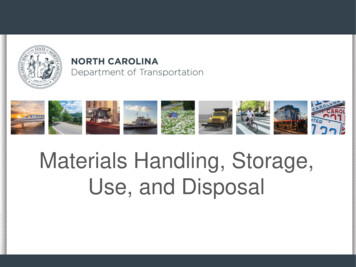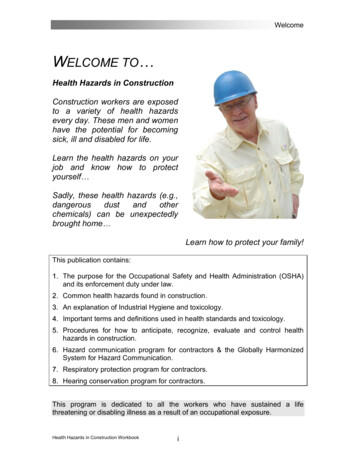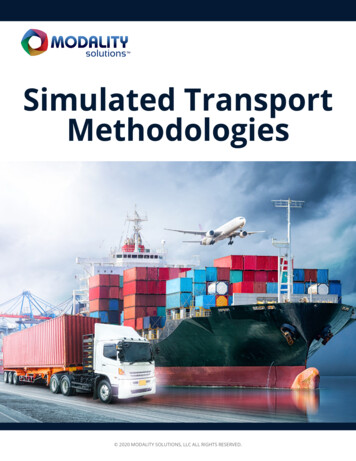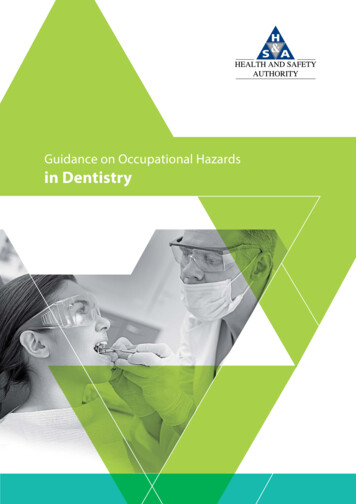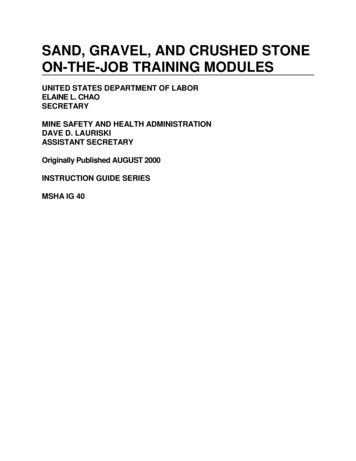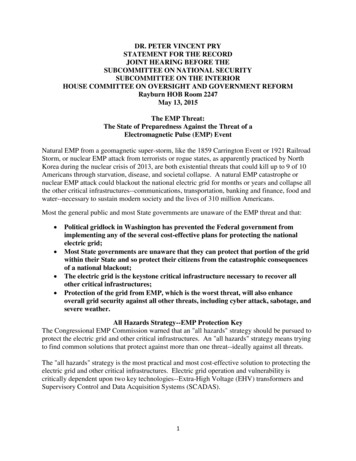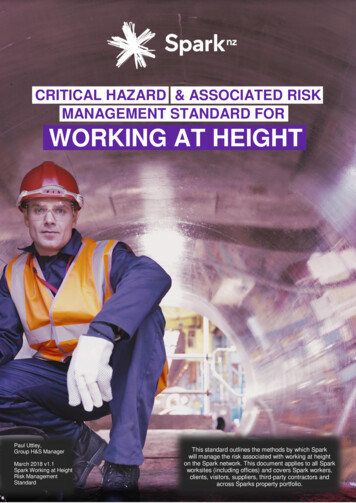
Transcription
CRITICAL HAZARD & ASSOCIATED RISKMANAGEMENT STANDARD FORWORKING AT HEIGHTPaul Uttley,Group H&S ManagerMarch 2018 v1.1Spark Working at HeightRisk ManagementMarch 2018 WAH Standard Final v1.1StandardThis standard outlines the methods by which Sparkwill manage the risk associated with working at heighton the Spark network. This document applies to all Sparkworksites (including offices) and covers Spark workers,clients, visitors, suppliers, third-party contractors and Spark New Zealand 2018across Sparks property portfolio. Page 1 of 32
Contents1.1.1.2.1.3.1.4.1.5.1.6.Working at Height at Spark . 3Purpose . 3Legal Outline . 3Related Legislation and Best Practice . 3Scope . 3Definitions of Terms and Acronyms Used . 32.1.2.2.2.3.Document Ownership . 4Document Version History. 4Roles and Responsibilities . 53.1.3.2.Worker Consultation . 6Spark WAH Standard Risk Profile . 74.1.4.2.Overview: Plan Do Check Act (PDCA) . 8Plan Do Check Act . 95.1.5.2.WAH Risk Management Process . 10Identify . 115.2.1. Competency requirements. 11Assess . 115.3.1. Risk assessment . 115.3.2. Risk Control Plan . 125.3.3. Spark and Supplier. 125.3.4. Safety in Design . 125.3.5. Eliminating, reducing or controlling foreseeable risks through design . 13WAH Documented Processes - Safe Systems of Work . 135.4.1. Safe system of work . 135.4.2. Safe Work Method Statement . 135.4.3. Permit to Work. 145.4.4. Applying for a permit. . 14Monitor & Review . 145.5.1. Monitor . 145.5.2. Review . 14WAH Emergency Procedure . 155.3.5.4.5.5.5.6.6.1.Scaffold and Temporary Working Platforms . 166.1.1. Planning. 166.1.2. Safe system of work . 166.1.3. Safety in Design . 166.1.4. Competency and Training Requirements. 176.1.5. Monitoring and Inspection. 176.2. Edge protection and guardrail systems. 176.2.1. Edge protection . 176.2.2. Guardrails . 186.3. Safety requirements for mobile scaffold platforms . 186.3.1. Competent person. 186.3.2. Pre-inspection . 186.3.3. Assembling Mobile scaffold . 186.3.4. Other mobile scaffold essentials. 196.4. Temporary Working Platform (TWP) . 206.4.1. Risk assessment . 206.5. Ladders / stepladders . 216.5.1. Spark supplied step ladders. . 216.5.2. Competency and Training. 216.6. Mobile Elevated Work Platform . 226.6.1. Competency and Training Requirements. 236.7. Harness Systems . 246.7.1. Total Restraint Systems . 246.7.2. Fall Arrest Systems . 256.7.3. Anchorage . 256.7.4. Harness . 256.7.5. Latchways Systems . 256.7.6. Work Positioning Systems . 266.7.7. Competency and Training Requirements. 266.8. Spark Mobile Towers, Cell Sites . 266.9. Falling Items . 276.10. Falls on same level surfaces . 286.10.1. Manager / Supervisor. 286.10.2. Worker . 28March 2018 WAH Standard Final v1.1 Spark New Zealand 2018Page 2 of 32
A fall from height is one of the most common industry related causes of injury or death. Spark recognises thatworking at height (WAH) is any situation where there is potential for a person to fall, or to injure anotherperson.This includes high and low-level off the ground work, as well as short duration and maintenance work that isregularly carried out across the Spark network.It is important to note, there is no ‘minimum height’: a person can be killed or sustain serious injury from a fallfrom ANY height. So, to make this clear, this standard applies to: any height where a person could fall, itemsfalling from height, or into an unprotected opening at ground level. This applies when carrying out their work,irrespective of what height they are working at or what that work involves.The purpose of this standard is to ensure that so far as is reasonably practicable, steps will be taken toeliminate or minimise those associated risks when a person is working at height at a Spark worksite, or whenworking at another company’s worksite where Spark has been granted access to carry out work. These stepswill include pre-planning, safe systems of work, risk management (assessment), worker consultation,monitoring and emergency planning. This document will be continually reviewed and on an annual basis.This Critical Hazard and Associated Risk Standard has been specifically developed to give the reader acomprehensive overview of how WAH is managed at Spark and is aligned with all stakeholder’s obligationsunder current H&S legislation.WAH shall be, so far as is reasonably practicable, managed within Spark in accordance with legislation andthe documents listed below in section 1.4Health and Safety at Work Act 2015Health and Safety at Work (General Risk and Workplace Management) Regulations 2016Health and Safety in Employment Regulations 1995Best Practice Guidelines for working at height in New /working-at-height/working-at-height-in-nz/Best Practice Guidelines for Mobile Elevating Work Platforms 2014Good Practice Guidelines for Scaffolding in New Zealand – Nov 2016Working on roofs – good practice Working safely at fe: https://worksafe.govt.nz/Spark H&S Supplier Policy 2017 http://www.sparknz.co.nz/about/suppliers/This document outlines the standard and framework that Spark will put in place to identify and manage anyhazards and risks associated with WAH on Spark worksites and that of its subsidiaries. It applies to all Sparkworksites (including offices) and covers Spark managers and employees, suppliers, service providers, internaland external project managers (PMs), delivery integrators, external consultants, designers, external visitors,clients, contractors and third-party contractors.Please see Section 7March 2018 WAH Standard Final v1.1 Spark New Zealand 2018Page 3 of 32
Prepared byPaul UttleyDate: March 2018SponsorRob BerrillDate: March 2018Approved byMark BederDate: March 2018Contact for enquiries and proposed changes to document template:Paul UttleySpark Group Health and Safety RIPTIONAUTHORISED112 Nov2017New WAHdocumentwrittenWritten by Group H&S ManagerPaul Uttley117 Jan2018AllFor review with HS teamPaul Uttley126 Jan2018AllFor review with Connect SLT &key personnelMark Beder, Rob Berrill,Paul Uttley1.120 March2018AllApprovedMark Beder, Rob Berrill,Paul UttleyMarch 2018 WAH Standard Final v1.1 Spark New Zealand 2018Page 4 of 32
Refer to the table below for roles and responsibilities:When more than one PCBU (person conducting a business or undertaking) have the same health and safetyduties in a WAH matter (e.g. overlapping duties) Spark will make sure, so far as is reasonably practicable thatthey consult, co-operate and co-ordinate with one another over the same matter. This will help avoidunnecessary duplication of effort and help prevent gaps in managing WAH related risks. In most instancesSpark will be a leader in promoting and encouraging good Health and Safety (H&S) practices at sharedworksites. Although, the nature of this leadership will reflect how much influence and control Spark have onworking at height risks at the shared workplace, and what is reasonably practicable in the circumstances.RoleResponsibilitySparkN.B Spark means allentities and peoplewho also haveresponsibilitiesinvolved in managingWAH activitiesSpark will make sure, so far as is reasonably practicable that: the H&S of Spark workers and others is not put at risk by any WAH activities beingundertaken across their worksites. It works closely with their suppliers and engaged contractors for managing andcontrolling WAH hazards and associated risks through a suitable PBCU and workersconsultative and participation process. both Spark and Supplier workers are provided clear guidance on how to effectivelymanage WAH critical hazards and associated risks through the content of thisstandard. Spark suppliers (in consultation with Spark Management) develop, deploy andmonitor suitable WAH safe systems of work when carrying out WAH activities acrossSpark worksites. make sure the H&S requirements of this standard are applied and monitored throughparticipation and consultation with Spark Management and Suppliers assist Spark Management in the review of safe systems of work for suppliers andcontractors (including WAH risk control plan) for best managing and controlling WAHhazard and associated risks. make sure a suitably competent and reputable contractor and sub-contractor isselected and engaged through a sound pre-qualification process for any type of WAHrelated works. prior to works commencing at a Spark worksite or office, liaise with the relevant Sparkteams, respective Project Manager (PM) and H&S Advisor for the selection of anycontractor undertaking critical WAH activities. make sure critical risk WAH activities are managed and controlled taking practicalguidance from this Risk Management Standard for WAH.Property Asset Manager,Facilities Manager,Internal PMs, DeliveryIntegrators, ExternalPMs engaged byproperty and servicecompanies) review and audit the performance of suppliers critical WAH activities in consultationwith the supplier and Spark H&S representative. work closely with any supplier or contractor or third-party contractor who may becarrying out critical WAH activities at a Spark worksite or office.Contractor and thirdparty contractor critical risk WAH activities are identified, assessed and controlled taking practicalguidance from Sparks Risk Management Standard for WAH. and make sure theycomply with the requirements of legislation and best practice. it develops and supplies risk assessments and Safe Work Method Statements(SWMS) for critical WAH activities when requested from Spark management or aSpark representative. workers or self-employed workers have the necessary knowledge, experience andqualifications to carry out WAH activities safely, and are supervised by competentpersonnel. they audit the performance of their WAH activities, self-employed and workers andmake sure they comply with the requirements of legislation and best practice. all workers are consulted with and provided the content of Sparks Risk ManagementStandard for WAH. they supply correct, suitable and safe WAH related plant and equipment includingPPE (personal protective equipment) always.Spark Health andSafety TeamSpark ProcurementTeamManager, managingWAH work on a Sparksite (including: SparkMarch 2018 WAH Standard Final v1.1 Spark New Zealand 2018Page 5 of 32
WAH has been identified and assessed as one our critical H&S hazards and associated risks at Spark. Therisks associated with WAH is prevalent across all parts of Spark’s business.Spark has introduced this Standard for WAH to provide practical guidance for Spark and supplier employees,when planning to control critical risks relating to WAH activities across all our worksites where practicable. It isimportant to note that although this standard covers our most prioritised critical risks that workers may beexposed to daily, it may not address all WAH associated risks encountered when working or carrying outworks across the Spark network.To further improve the H&S risk management process, Spark will always consult with their available resourcesand expertise within the business (i.e. managers and employees, designers, H&S team and suppliers) mainlyat the planning and design stage of any Spark H&S risk management process. This consultative processenables Spark to define the context and basic parameters within which critical hazard and associated risksmust be managed.This Risk Management Standard was developed in consultation with Spark’s H&S team, Spark managers,employees and suppliers, who manage and carry out WAH works for Spark. This consultation processoccurred between 15 – 23 November 2017 via worker feedback, where a Spark request was made for suitableworker representation made up of the above persons, who were requested to complete and return the simpletable below.Working at Height FeedbackWAH activities: examples mechanical and electrical servicesmaintenance works, above a ceiling grid orcable tray. Network maintenance from a roof area. How are theseactivities andassociated H&Srisks currentlycontrolled? What could be doneto improve and makethese WAH activitiessafer General building and office maintenance.All worker feedback was then collated into a register and reviewed to help determine what is occurring forWAH activities at Spark worksites and how risks are currently managed and controlled by Spark and theirsuppliers. All recommendations were considered, then suitable improvements were applied to thedevelopment of this Risk Management Standard for WAH. Recommendations included: Consider safety in design during the planning stage of risk management. Better standards concerning management and the detailing of WAH task to workers and identificationof risks. A standard that gives our suppliers practical advice on conducting a risk assessment forworking at heights. Offer links to WorkSafe best practice guidelines. Only competent and qualified workers to carry out work at height. Make the use of temp work platforms mandatory (not step ladders) when carrying out short durationworks and offer guidance on the safe assembly, use and movement of mobile scaffold. We need not only produce a professional standard but deliver it out to the contractor communityin a meaningful way with our Senior Leader’s support. Make sure that Spark expect an individual using a step ladder to have had this approvedas part of a risk control plan approved by their employer.March 2018 WAH Standard Final v1.1 Spark New Zealand 2018Page 6 of 32
WAH at Spark is broad in terms of the many different types of tasks being frequently carried out each dayacross our network and worksites. This Standard will take a risk-based approach and focusses on the criticalrisk WAH activities that occur at Spark on a regular basis i.e. Where negative outcomes could lead to a fatalityor a person’s future being permanently altered, or where plant, property or equipment damage could haveresulted in fatality, serious or personal harm, injury or illness.The following WAH activities were identified and assessed as critical within the Spark WAH risk profile, andseveral of these will be discussed in detail for the remainder of this document: Where a person works from orwithin or uses a specific WAH system or piece of plant or equipment. Roof Ceiling void Mobile cell tower / mast / antennae Temporary work platforms (scaffolding, mobile scaffolds, ladders and step ladders) Mobile Elevated Working Platforms (MEWP) Fall arrest and fall restraint systems Within proximity of an unprotected opening at ground levelSpark Risk Assessment ModelIDENTIFYHazardsRISK ASSESSMENTLikelihood x Consequence Lev el of RiskHIERARCHY OF CONTROLEliminateSubstituteIsolateEngineering ControlsReduced Risk Controls (minimise)March 2018 WAH Standard Final v1.1Safe System of WorkAdministrationPersonal Protective EquipmentSupervisionSignageReliability level of controlReasonably PracticableIdeal Risk Controls (eliminate or reduce) Spark New Zealand 2018Page 7 of 32
The following PDCA system is a basic yet effective risk management system used for continual improvementfor managing WAH activities and will be adopted by Spark to provide an easy to follow sequence and overviewof their current list of Critical Hazard and Associated Risk Management Standards. The sequence and flowchart illustrated within section 4.2 will be used for its application at the following two levels:1. The planning and risk assessment of identified WAH critical hazards and associated risksthat apply at a Spark Worksite or office (Plan)2. The application, monitoring and review of WAH controls at a Spark worksite or office(Do, Check, Act)PlanningThe purpose of planning using the PDCA system is to establish a risk profile of existing and potential WAHhazards and risks, across Spark’s worksites and what types of remedial works are to be applied and thenagree on the appropriate WAH risk controls. This will require a risk assessment which is the Spark WAH riskmanagement process (refer to sec 5.1) to identify the nature and extent of the risks, and the possible optionsfor control measure.Standards (legal and other requirements)Legal and other requirements (e.g. SWI, COP, Guidelines and Standards etc.) must be first identified andapplied, since agreed risk control measures are unlikely to be appropriate and effective if they do not satisfythe same requirements.DoThis part of the PDCA approach consists of implementing WAH risk controls measures as agreed inconsultation during the planning and design stage of the same process. For our suppliers this would includedocumenting and applying safe systems of work such as task specific risk assessment and Safe Work MethodStatements (SWMS), Job Safety Analysis, work permits and daily pre-start meetings where applicable.CheckThe minimum requirement for checking is monitoring. This is to make sure that agreed risk controls areeffective, realistic and practical in their execution by both Spark and their suppliers and have met with theagreed task specific risk controls as detailed within any pre-submitted safe systems of work as detailed above.ActThe Act element is achieved by regularly reviewing and acting on all issues raised within the Check (e.g.monitor and measure) element of the PDCA Sequence, and discussing with all those involved within the sameprocess e.g. what is and what isn’t working? Are current controls adequate to protect people from falling atheight or items falling from height?March 2018 WAH Standard Final v1.1 Spark New Zealand 2018Page 8 of 32
OtherConsiderationsWAH Risk ManagementProcess (refer to sec 5.1)PLANIdentify WAH critical hazardsand associated risksWAH hazards & risks areevident or reported at SparkThere are two approaches toconsider here (sec 5.2)Assess the suitability of anyexisting & permanent controlsEngage competent person tocarry out WAH surveyA WAH Surveyor / Assessormust be competent (5.2.1)Assess risk: likelihood xconsequence level of riskDiscuss findings in consultationwith relevant stakeholdersRemember to use worker andPCBU consultation (3.2)Analyse risk and decidewhether risk is acceptableIf WAH hazards are identified,then carry out risk assessmentUse competent person for riskassessment (5.2.1)Select appropriate methodsof risk controlOutcomes discussed & reviewed- suitable controls agreedUse Hierarchy of Fall Preventionwhen selecting controls (5.3.2)Spark and contractors to applymethod of risk controlApply WAH risk controlsContractors must be competent& pre-qualified through SparkprocurementSAFE WORKDOPROCEDURESOTHERCONSIDERATIONSApply WAH specific riskassessment (5.3.1)Start work in accordance withRisk Control Plan(5.3.2, 5.3.3)Spark & contractor RCPs will bereviewed on a regular basis(5.5.2)Apply documented SafeSystems of Work (5.4)Apply recommendedWAH Risk Control MeasuresUse the Spark Hierarchy of FallPrevention always.MONITOR (sec 5.5.1)CHECKMEASURECompetent Person to ensure thatWAH risk controls are effectiveIs the work in accordance withthe Spark WAH Standard?Spark and Supplier has met allWAH standard requirementsAgreed WAH risk controls aremonitored (sec 5.5.1)Has the agreed safe system ofwork been applied?Agreed safe system of workdeployed by Spark / supplierDeploy a fit for purpose criticalrisk audit for WAHHave the agreed risk controlsbeen implementedAll agreed risk controlsare in placeDaily monitoring for criticalWAH activities (sec 5.5.1)Have all the agreed monitoringrequirements been appliedRecord of audits andinspections submitted to SparkACTBY WHOMStop work if any person orentity is at serious risk of injuryAny Spark employee orsupplier / contractor working ata Spark worksiteHOWUse the above monitoringrequirements to identifyany failure of safe systems ofwork andrisk control failuresMarch 2018 WAH Standard Final v1.1Take immediate action and reviewany identified failures of safesystem of work or risk control.Spark Manager, H&S team orcontractors’ supervisor Spark New Zealand 2018Page 9 of 32
This section outlines how WAH hazards and risks will be managed at a Spark’s worksite.The objective of the below process is to make sure that Spark establishes a safe WAH environment in whichexposure to WAH activities and its associated risks are eliminated or minimised where practicable. In addition,suitable risk assessments are to be carried out to make sure that all known hazards and recommended riskcontrols are recorded and made available to workers accessing a specific work area.This following process has been designed to make sure that: Both Spark and suppliers inherent and work activity related WAH hazards are identified, assessed,controlled and monitored, and that any other height related hazards and risks are considered
Risk Management Page 1 of 32 Group H&S Manager Paul Uttley, March 2018 v1.1 Spark Working at Height Standard This standard outlines the methods by which Spark will manage the risk associated with working at height on the Spark network. This document applies to all Spark worksites (including offices) and covers Spark workers,
